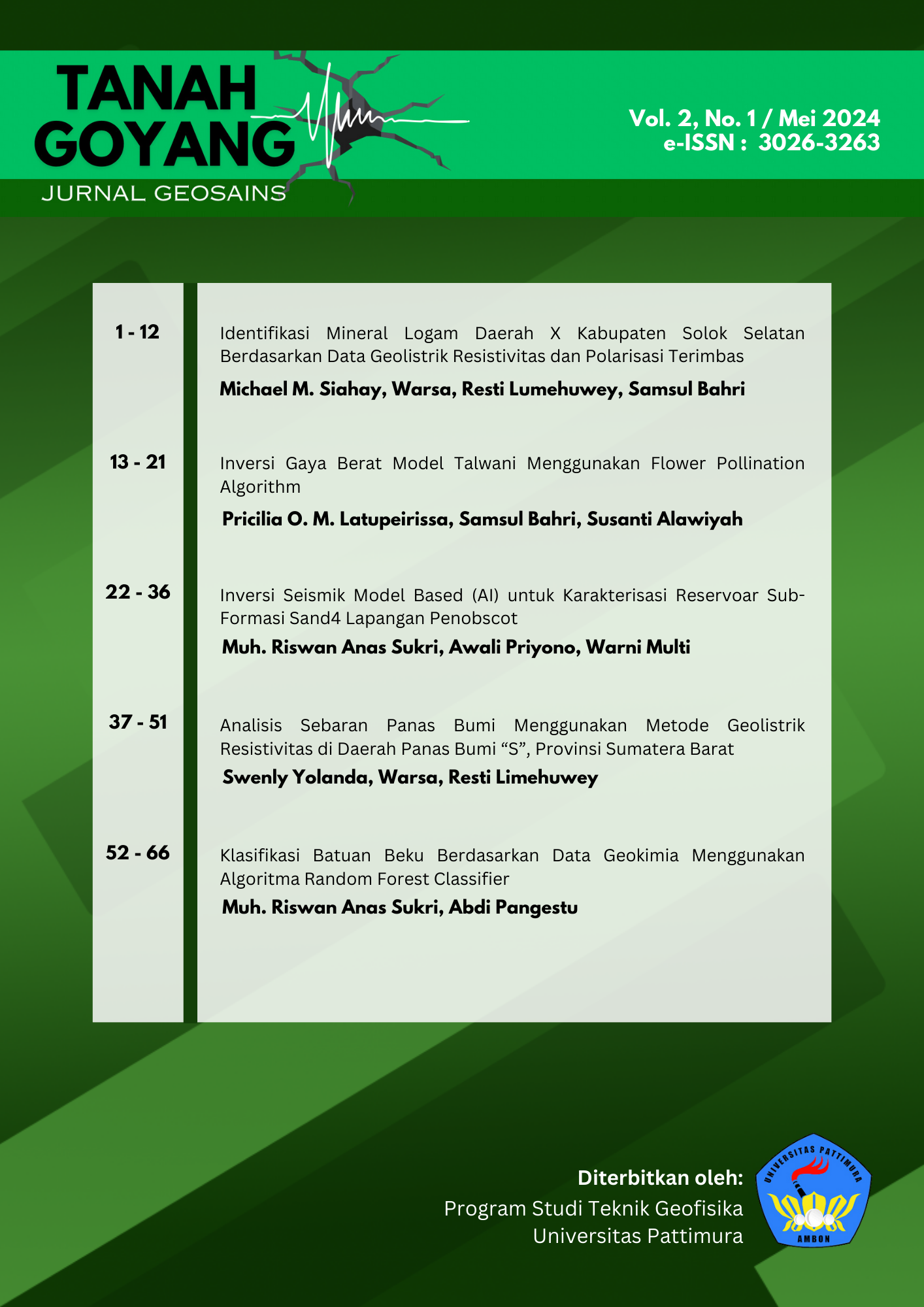Klasifikasi Batuan Beku Berdasarkan Data Geokimia Menggunakan Algoritma Random Forest Classifier
Abstract
Identifikasi dan klasifikasi batuan berdasarkan karakteristik visual batuan adalah proses yang subjektif dan menggunakan metode yang sama dapat menghasilkan hasil yang berbeda. Pengembangan machine learning telah membuka cara baru untuk mengklasifikasikan batuan. Penelitian ini akan dilakukan untuk mengklasifikasikan batuan beku berdasarkan data geokimia menggunakan algoritma Random Forest Classifier. Random forest adalah algoritma machine learning yang menggunakan kombinasi pohon keputusan untuk membuat prediksi yang akurat guna menentukan cara yang lebih tepat dalam memproses data. Model menunjukkan performa yang cukup baik dengan akurasi 89.4% pada data test. Pada data test, nilai precision berkisar antara 0.75 hingga 1.00, recall antara 0.80 hingga 1.00, dan f1-score antara 0.78 hingga 0.98. Variabel paling penting dalam model klasifikasi batuan ini adalah SIO2_WT%, dengan penurunan skor rata-rata terbesar sekitar 0.30, diikuti oleh MNO_WT% dan FEOT_WT%. Variabel lain memiliki penurunan skor rata-rata yang lebih kecil, menunjukkan kontribusi yang lebih rendah.
Downloads
References
Alférez, G. H., Serrano, S. H., Ardila, A. M. M., and Clausen, B. L. (2021). Automatic Classification of Plutonic Rocks with Machine Learning Applied to Extracted Shades and Colors on iOS Devices. Proceedings of the Future Technologies Conference (FTC), 72–88.
Alhams, A., Abdelhadi, A., Badri, Y., Sassi, S., and Renno, J. (2024). Enhanced Bearing Fault Diagnosis Through Trees Ensemble Method and Feature Importance Analysis. Journal of Vibration Engineering and Technologies, 0123456789. https://doi.org/10.1007/s42417-024-01405-0.
Bamford, T., Esmaeili, K., and Schoellig, A. P. (2021). A deep learning approach for rock fragmentation analysis. International Journal of Rock Mechanics and Mining Sciences, 145. https://doi.org/10.1016/j.ijrmms.2021.104839.
Buitinck, L., Louppe, G., Blondel, M., Fabien, P., Mueller, A., Olivier, G., Niculae, V., Prettenhofer, P., Gramfort, A., Grobler, J., Layton, R., VanderPlas, J., Joly, A., and Varoquaux, G. (2011). Scikit-learn: Machine Learning in Python. Journal of Machine Learning Research, 12, 2825–2830. http://scikit-learn.sourceforge.net.
Caté, A., Schetselaar, E., Mercier-Langevin, P., and Ross, P. S. (2018). Classification of lithostratigraphic and alteration units from drillhole lithogeochemical data using machine learning: A case study from the Lalor volcanogenic massive sulphide deposit, Snow Lake, Manitoba, Canada. Journal of Geochemical Exploration, 188, 216–228. https://doi.org/10.1016/j.gexplo.2018.01.019.
Ferrer, C. A., and Aragón, E. (2023). Note on “A Comprehensive Analysis of Synthetic Minority Oversampling Technique (SMOTE) for handling class imbalance.” Information Sciences, 630, 322–324. https://doi.org/10.1016/j.ins.2022.10.005.
Houshmand, N., GoodFellow, S., Esmaeili, K., and Ordóñez Calderón, J. C. (2022). Rock type classification based on petrophysical, geochemical, and core imaging data using machine and deep learning techniques. Applied Computing and Geosciences, 16. https://doi.org/10.1016/j.acags.2022.100104.
Kantu, R. R. (2022). Geokimia Batuan Kubah Lava Daerah Bulu Dua Kecamatan Tanete Riaja Provinsi Sulawesi Selatan [Universitas Hasanuddin]. In Doctoral dissertation, Universitas Hasanuddin (Issue 8.5.2017). www.aging-us.com.
Li, X., and Li, H. (2013). A new method of identification of complex lithologies and reservoirs: task-driven data mining. J. Petrol. Sci. Eng, 109, 241–249. https://doi.org/10.1016/%0Aj.petrol.2013.08.049.
Mangalathu, S., and Burton, H. V. (2019). Deep learning-based classification of earthquake-impacted buildings using textual damage descriptions. International Journal of Disaster Risk Reduction, 36. https://doi.org/10.1016/j.ijdrr.2019.101111
Myrtveit, I., Stensrud, E., and Olsson, U. H. (2001). Analyzing data sets with missing data: An empirical evaluation of imputation methods and likelihood-based methods. IEEE Transactions on Software Engineering, 27(11), 999–1013. https://doi.org/10.1109/32.965340.
Niu, G., He, X., Xu, H., and Dai, S. (2024). Development of Rock Classification Systems: A Comprehensive Review with Emphasis on Artificial Intelligence Techniques. Eng, 5(1), 217–245. https://doi.org/10.3390/eng5010012.
Pane, S. A., dan Sihombing, F. M. H. (2020). No TitleKlasifikasi dan klasterisasi mineral batuan di lapangan x berdasarkan data spektral (SWIR & TIR) menggunakan metode pembelajaran mesin = Classification and clasterization of rock minerals in field x based on spetral data (SWIR & TIR) using machine. Universitas Indonesia.
Prandika Siregar, A., Priyadi Purba, D., Putri Pasaribu, J., Reza Bakara, K., dan Willem Iskandar Pasar Medan Estate, J. V. (2023). Implementasi Algoritma Random Forest Dalam Klasifikasi Diagnosis Penyakit Stroke. Jurnal Penelitian Rumpun Ilmu Teknik (JUPRIT), 2(4), 155–164. https://doi.org/10.55606/juprit.v2i4.3039.
Ran, X., Xue, L., Zhang, Y., Liu, Z., Sang, X., and He, J. (2019). Rock classification from field image patches analyzed using a deep convolutional neural network. Mathematics, 7(8), 755. https://doi.org/10.3390/math708075.
Turlapati, V. P. K., and Prusty, M. R. (2020). Outlier-SMOTE: A refined oversampling technique for improved detection of COVID-19. Intelligence-Based Medicine, 3–4. https://doi.org/10.1016/j.ibmed.2020.100023.
Williams, H., Turner, F. J., and Gilbert, C. M. (1982). Petrography: an introduction to the study of rocks in thin sections. In Petrography: an introduction to the study of rocks in thin sections. W.H. Freeman Company. https://doi.org/10.5408/0022-1368-3.1.34.








1.png)

